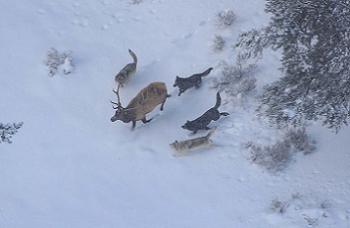28
Sep
Large Predators Are Critical to the Stability of Our Natural Areas
This is a guest post [on a Defenders of Wildlife Blog] from Dr. James A. Estes, a professor in the Department of Ecology and Evolutionary Biology at the University of California, Santa Cruz.

In a world containing some 10 million or more species, the current tide of extinction cannot be stemmed one species at a time. More general strategies are needed. Nearly everyone understands this fundamental truth. But what are these strategies? Although the devil is in the details, the answer in the minds of most conservation thinkers and planners hinges on a single key factor—habitat. All species require habitat to survive and reproduce. Preserve enough habitat in the right places and species preservation will follow. The problem is that this strategy isn’t working very well. We continue to loose species, even from the largest conservation areas. So what’s the problem? It might be that the strategy is fine but we have yet to get the details right—enough habitat with sufficient protection in the right places. Or it might be that something more is needed.
On 13 July, 2011, I coauthored a review in the journal Science with 23 other ecologists from around the world in which we argue that something more is indeed needed. That something is the apex consumers. Our argument is this. Large apex consumers—creatures like lions, wolves, bears and killer whales—are key elements of nature. Virtually all habitats have had them for millions of years. That is, until recently. These large apex consumers have been among the first species to disappear from our increasingly human-dominated world. And along with the loss of these animals has been the loss of something even more fundamental—the essential roles they play in holding their ecosystems together. We are beginning to see these roles nearly everywhere—from the tropics to the poles, and on land, in rivers and lakes, and in the sea.
Our review details the theoretical basis for this phenomenon and provides many specific examples. My favorite example is the link between sea otters and coastal ecosystems in the North Pacific Ocean. The loss of otters has led to population irruptions of their prey—sea urchins. Hyperabundant urchins overgraze kelp forests, leading in turn to reductions or the loss of species and ecosystem services that depend on kelp forests. Similarly, the loss of wolves, grizzly bears and cougars from much of North America has led to population irruptions of their prey—moose, elk and deer—which in turn have overgrazed their range, thus leading to the loss of both plant species and the animals that depend on these plants. In another well known example, the loss of coyotes from chaparral fragments in southern California has allowed these habitats to be invaded by “mesopredators”—cats, foxes, and other small carnivore—that in turn have caused the extinction of birds and other small vertebrates. The list goes on and on.
These are not unique stories but examples of a global phenomenon. And the effects of apex consumers extend widely across ecosystems to influence such diverse phenomena as wildfire, disease, and air and water quality. Trophic downgrading, which begins with the loss of large apex consumers from nature, can be thought of as an ecological chain reaction that is part and parcel to the biodiversity crisis. “¦
The bottom line for conservation is simply this. Habitat is necessary but insufficient for biodiversity conservation. Apex consumers are also required to run nature’s engine.
To read the full article and see video with the author and additional links, click here



